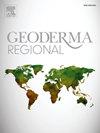评估火山灰沉积对毛伊岛气候序列土壤风化状况的元素趋势和风化指数
IF 3.1
2区 农林科学
Q2 SOIL SCIENCE
引用次数: 0
摘要
茂宜岛哈雷阿卡拉(Haleakalā)的西坡受到地形气候效应的极大影响,形成了巨大的降水梯度和雨影,对玄武岩中形成的土壤的成土风化和分化产生了重大影响。然而,由于东茂宜岛西北裂谷沿线火山喷口的存在,火山灰在整个地形上的沉积并不规则,因此很难确定土壤的相对年龄及其受火山灰影响的程度。本研究的目标是:1)描述在广泛的气候梯度中采样的花盆的玄武岩基质并对其进行分类;2)确定元素组成和土壤化学性质如何随降水和海拔而变化;3)确定哈雷阿卡拉西部气候序列的成土阈值;4)确定元素趋势和风化指数是否能区分受火山灰影响的花盆和土壤层。我们在库拉火山岩面向西北的斜坡上采集了 16 个土壤样本,这些土壤跨越了库拉火山岩形成的海拔和降水梯度。土壤取样和描述深度为 1 米。通过 X 射线荧光测定了岩石样本和土壤层的总元素分析,并在实验室测量了土壤的各种物理和化学特性。我们计算了沿海和海拔气候序列的 22 项风化指数。土壤基岩样本为碱性玄武岩,主要归类为闪长玄武岩,有四个样本归类为闪长岩。我们确定了年平均降水量(MAP)分别为 500 毫米和 1300 毫米的沿海气候序列的二氧化硅/二氧化钛成土阈值,结果表明,虽然卡互陆伊(AIR)的基质年平均降水量(MAP)低于派亚(CEM、PAIA)的两个基质,但其风化程度更高。结晶铁(CD-AO)在低于 1500 毫米 MAP 的血统中变化不定,随着 MAP 的增加而急剧增加,然后在 OL 和 HAI-E 血统中减少,这可能是由于铁的还原和损失。一般来说,海拔较低的血统中结晶铁(CD-AO)含量较高,这可能是由于低地土壤的年龄相对较老。二氧化硅/二氧化钛(SiO2/TiO2)的值一般随土壤深度的增加而降低,但由于火山灰的影响,随着降水量的增加,整块土壤的二氧化硅/二氧化钛(SiO2/TiO2)值变化很大,而在降水量大的土壤中,该值也会大幅下降。土壤二氧化硅/二氧化钛(SiO2/TiO2)和氧化锰/二氧化钛(MnO/TiO2)与花盆岩石碎片的归一化值可能是区分火山灰还原土壤花盆和遗传地层与非火山灰还原土壤花盆和遗传地层的可行指标。本文章由计算机程序翻译,如有差异,请以英文原文为准。
Elemental trends and weathering indices to assess volcanic ash deposition on soil weathering status along Maui climosequences
The western slopes of Haleakalā, Maui, are greatly affected by an orographic climate effect, creating a massive precipitation gradient and rain shadow with significant impact on pedogenic weathering and differentiation of soil formed in basalt. However, the presence of volcanic vents along East Maui's northwest rift have created irregularity in the deposition of volcanic ash across the landscape, making it difficult to determine a soil's relative age and degree of ash influence on its development. The objectives of this study were to 1) characterize and classify the basalt substrate of pedons sampled across a wide climatic gradient; 2) determine how elemental composition and soil chemical properties vary with precipitation and elevation; 3) identify pedogenic thresholds of western Haleakalā climosequences; and 4) determine if elemental trends and weathering indices can distinguish pedons and soil horizons that have been influenced by volcanic ash. We sampled 16 soils across elevational and precipitation gradients formed in Kula Volcanics on northwest-facing slopes <5 %. Soils were sampled and described to 1-m depth. Total elemental analysis was determined on rock samples and soil horizons by x-ray fluorescence, and various soil physical and chemical properties were measured in the laboratory. We calculated a total of 22 weathering indices across coastal and elevational climosequences. Soil pedon rock samples were alkalic basalt and predominantly classified as tephrite basanite with four samples classifying as foidite. We identified pedogenic thresholds for SiO2/TiO2 at 500 mm and 1300 mm mean annual precipitation (MAP) for the coastal climosequence, showing that although the pedon in Kahului (AIR) had lower MAP than the two pedons in Paia (CEM, PAIA), it is more weathered. Crystalline Fe (CD-AO) was variable in pedons below 1500 mm MAP, increased sharply with increased MAP, then decreased in pedons OL and HAI-E likely due to the reduction and loss of iron. Crystalline Fe (CD-AO) was generally higher at lower elevation pedons likely due to the relatively older age of lowland soils. Values of SiO2/TiO2 generally decreased with soil depth, but whole pedon values of SiO2/TiO2 were highly variable with increasing precipitation due to the influence of volcanic ash before also dropping substantially in high rainfall pedons. Soil SiO2/TiO2 and MnO/TiO2 normalized to the pedon rock fragments may be viable indicators for distinguishing ash-rejuvenated soil pedons and genetic horizons from those that are not.
求助全文
通过发布文献求助,成功后即可免费获取论文全文。
去求助
来源期刊

Geoderma Regional
Agricultural and Biological Sciences-Soil Science
CiteScore
6.10
自引率
7.30%
发文量
122
审稿时长
76 days
期刊介绍:
Global issues require studies and solutions on national and regional levels. Geoderma Regional focuses on studies that increase understanding and advance our scientific knowledge of soils in all regions of the world. The journal embraces every aspect of soil science and welcomes reviews of regional progress.
 求助内容:
求助内容: 应助结果提醒方式:
应助结果提醒方式:


